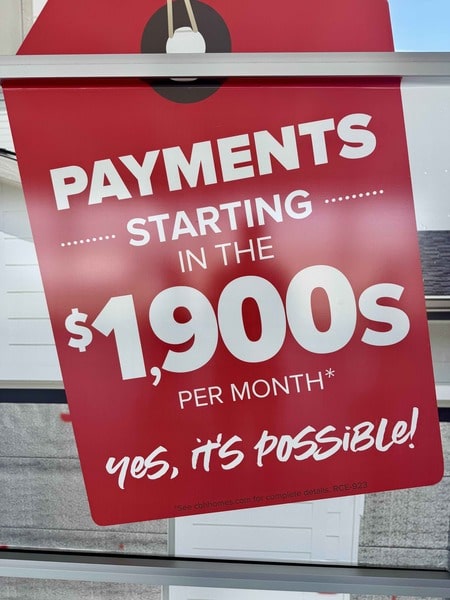Once upon a time, it was pretty common to see a new housing development flanked by a sign saying something like, “Starting in the low $300’s.”
In fact, I can still remember signs that read: “Priced from the $100’s.”
But now that the price point of new homes doesn’t sound so low, home builders seem to be employing a new strategy.
Instead of featuring the asking price on some of their ads, they’re leading with a monthly payment to capture more eyeballs.
It’s a smart approach, and something I came across recently on a trip to Boise, Idaho.
Using Payments Instead of Prices to Sell Homes

Upon landing at Boise’s airport last week, I stumbled upon this advertisement from a local Idaho builder.
There was no mention of home prices in their giant ad plastered on the skyway of the airport.
But there was a prominent monthly payment displayed, along with the phrase, “Yes, it’s possible.”
It stood out to me because I’ve been so used to seeing the home builder ads with the home prices listed.
This particular ad had monthly payments starting in the $1,900s, which could appeal to prospective buyers who might pay less (or a similar amount) in rent.
Conversely, if they saw an ad saying “starting in the $300s,” that same renter might think homeownership is completely out of reach for them.
So home builders can kind of change the narrative to “it’s within reach” by showing the customer a monthly payment instead of a six-figure price tag.
It’s just like the ads you see for a new car, where the dealer lists a monthly lease/loan price in big bold font, and a much less prominent price tag below in the fine print.
You might not think you can afford the $80,000 truck, but if the payment is only X amount per month, you could be convinced otherwise.
This is what some home builders are doing now to unload their for-sale inventory, especially with affordability so poor today.
The Home Builder Is Doing the Math for the Customer
What’s happening here is the home builder is doing the math for their prospective customer.
Instead of saying, “Hey, our homes cost $325,000,” they’re skipping a step and providing a hypothetical monthly payment their customer might be able to afford.
We all know mortgages are fairly complicated, and not everyone knows how to break it down from the purchase price.
And if a customer could potentially be turned off by a certain price (i.e. I would never pay that for a home here!), this approach could assuage any hesitation.
It might turn out that the renter could afford the $325,000 home as well, but they might not realize it because they’d have to do the math first.
Or they could simply balk at X purchase price, as noted.
So the home builders are pretty smart here, and chances are they’ll sell more homes with a campaign like this.
Granted, I did wonder what the math actually looked like so I dug in a little more.
To arrive at that ~$1,900 payment, they were using a home priced at $326,990 with a 3.5% down payment.
That makes it roughly $1,943.00 per month, as the advertisement stated (in the $1,900s).
But What Monthly Costs Are Actually Included?
Now I’m not trying to pick on this particular home builder, but I do want to explain how they arrived at their monthly estimate.
They did so with an FHA loan, including only the principal and interest portion of the payment.
As you might know, a mortgage payment is often represented as PITI, or principal, interest, taxes, and insurance.
There is also compulsory mortgage insurance on FHA loans, which wasn’t included in the ~$1,900 cost, nor were the property taxes or homeowners insurance.
Oh, and let’s not forget HOA dues, which also seem to apply in the new housing tract.
If we estimate those costs, it might be $300 a month for property taxes, $75 for homeowners insurance, $50 for HOA dues, and $150 for mortgage insurance.
Taken together, that’s another $575 per month, which once added to the $1,943 in principal and interest comes out to about $2,500.
In other words, the $1,900s was used rather loosely and didn’t incorporate many of the actual costs of homeownership that are unavoidable.
Not to mention other costs like maintenance and repairs, which home buyers often ignore.
This isn’t to say you should continue renting and not buy a home, but it’s important to get the full picture, especially when making such a big decision.
Ultimately, if you’re not doing the math (like I just did), you shouldn’t be moving forward.
A home purchase is clearly a big deal and one that takes a lot of thought, research, and planning. Act accordingly.
Read on: Should I use the home builder’s mortgage lender?

